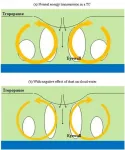(Press-News.org) The Amazon rainforest is teeming with creatures unknown to science--and that's just in broad daylight. After dark, the forest is a whole new place, alive with nocturnal animals that have remained even more elusive to scientists than their day-shift counterparts. In a new paper in Zootaxa, researchers described two new species of screech owls that live in the Amazon and Atlantic forests, both of which are already critically endangered.
"Screech owls are considered a well-understood group compared to some other types of organisms in these areas," says John Bates, curator of birds at the Field Museum in Chicago and one of the study's authors. "But when you start listening to them and comparing them across geography, it turns out that there are things that people hadn't appreciated. That's why these new species are being described."
"Not even professional ornithologists who have worked on owls for their entire lives would agree about the actual number of species found in this group, so a study like ours has been awaited for a really long time," says Alex Aleixo, head of the research team responsible for the study, and currently curator of birds at the Finnish Museum of Natural History in the University of Helsinki, Finland.
The newly-discovered screech owls are cousins of the Eastern Screech Owls that are common in the United States. "They're cute little owls, probably five or six inches long, with tufts of feathers on their heads," says Bates. "Some are brown, some are gray, and some are in between." Until this study, the new species were lumped together with the Tawny-bellied Screech Owl and the Black-capped Screech Owl, which are found throughout South America.
Teasing out the differences between the species started with years of fieldwork in the Amazon rainforest as well as the Atlantic forest running along the eastern part of Brazil and surrounding countries. Bates, who usually conducts fieldwork during the day, says that doing fieldwork in the rainforest at night comes with new challenges. "For me it's more a feeling of fascination than being scared, but at the same time, you're running into spider webs. If you're wearing a headlight you see the eyeshine of the nocturnal animals. One time I was stepping over a log and I looked down and there was a tarantula the size of my hand just sitting there," says Bates. "If I had been a kid I would have been scared to death."
The owls that the researchers were looking for live in the trees, often a hundred feet above the forest floor. That makes studying them difficult. But the researchers had a secret weapon: the screech owls' namesake screech.
"To draw the birds out, we used tape recordings," explains Bates. "We'd record their calls and then play them back. The owls are territorial, and when they heard the recordings, they came out to defend their territory."
The scientists compared the birds' calls and found that there were variations in the sounds they made, indicative of different species. They also examined the birds' physical appearances and took tissue samples so they could study the owls' DNA at the Field Museum's Pritzker DNA Lab.
Altogether, 252 specimens, 83 tape-recordings, and 49 genetic samples from across the range of the Tawny-bellied Screech Owl complex in South America were analyzed. A significant number of specimens were collected by the research team itself, especially the study's lead author Sidnei Dantas, who spent a good share of his time in graduate school searching for and tape-recording screech owls in South American rainforests. In addition, natural history collections and their materials collected over the centuries were essential to complete the study´s unprecedented sampling.
"The study would not have been possible if it were not for the great biological collections in Brazil and USA which I visited during my work, and that sent us essential material, either genetic and morphological. This highlights the importance of such research institutions for the progress of science and hence of the countries they represent," says Dantas, who conducted the study as part of his PhD dissertation at the Goeldi Museum in Belém and is currently working as a nature guide in Brazilian Amazonia.
The combination of genetic variation, physical differences, and unique vocalizations led the team to describe two new species in addition to the previously known Tawny-bellied Screech Owl: the Xingu Screech Owl and the Alagoas Screech Owl. The Xingu owl's scientific name is in honor of Sister Dorothy May Stang, an activist who worked with Brazilian farmers to develop sustainable practices and fight for their land rights; its common name is for the area where the owl is found near the Xingu River. The Alagoas owl's name is a reference to the northeastern Brazilian state of Alagoas where the owl is primarily found.
While the owls are new to science, they're already in danger of disappearing forever. "Both new species are threatened by deforestation," says Jason Weckstein, associate curator of Ornithology in the Academy of Natural Sciences of Drexel University and associate professor in the university's Department of Biodiversity, Earth, and Environmental Science. "The Xingu Screech Owl is endemic to the most severely burned area of the Amazon by the unprecedented 2019 fires, and the Alagoas Screech Owl should be regarded as critically endangered given the extensive forest fragmentation in the very small area where it occurs," says Weckstein, who is a co-author and began work on this project as a postdoctoral researcher at the Field Museum.
Bates says he hopes that the study will shed light on how varied the Amazon and Atlantic forests are and how simply protecting certain areas isn't enough to preserve the forests' biodiversity. "If you just say, 'Well, you know Amazonia is Amazonia, and it's big,' you don't end up prioritizing efforts to keep forests from being cut in these different parts of Amazonia. That could mean losing entire faunas in this region," says Bates.
In addition to the study's conservation implications, the authors highlight the international collaboration that made the work possible. "This study shows how important it is to train the next generation of scientists at a global level," says Bates. "That means to having students like Sidnei come from Brazil and work in the Field's Pritzker Lab and measure specimens in our collection for their research. It's a great thing to build those connections."
INFORMATION:
Scientists estimate that dark matter and dark energy together are some 95% of the gravitational material in the universe while the remaining 5% is baryonic matter, which is the "normal" matter composing stars, planets, and living beings. However for decades almost one half of this matter has not been found either. Now, using a new technique, a team in which the Instituto de Astrofísica de Canarias (IAC) has participated, has shown that this "missing" baryonic matter is found filling the space between the galaxies as hot, low density gas. The same technique also gives a new tool that shows that the gravitational attraction experienced by ...
Researchers from Queen Mary University of London have developed a machine learning algorithm that ranks drugs based on their efficacy in reducing cancer cell growth. The approach may have the potential to advance personalised therapies in the future by allowing oncologists to select the best drugs to treat individual cancer patients.
The method, named Drug Ranking Using Machine Learning (DRUML), was published today in Nature Communications and is based on machine learning analysis of data derived from the study of proteins expressed in cancer cells. Having been trained on ...
The interiors of nonflowering trees such as pine and ginkgo contain sapwood lined with straw-like conduits known as xylem, which draw water up through a tree's trunk and branches. Xylem conduits are interconnected via thin membranes that act as natural sieves, filtering out bubbles from water and sap.
MIT engineers have been investigating sapwood's natural filtering ability, and have previously fabricated simple filters from peeled cross-sections of sapwood branches, demonstrating that the low-tech design effectively filters bacteria.
Now, the same team has advanced the technology and shown that it works in real-world situations. They have fabricated new xylem filters that can filter out pathogens ...
An international team of scientists has found evidence that SARS-CoV-2, the virus that causes COVID-19, infects cells in the mouth. While it's well known that the upper airways and lungs are primary sites of SARS-CoV-2 infection, there are clues the virus can infect cells in other parts of the body, such as the digestive system, blood vessels, kidneys and, as this new study shows, the mouth. The potential of the virus to infect multiple areas of the body might help explain the wide-ranging symptoms experienced by COVID-19 patients, including oral symptoms such as taste loss, ...
Philadelphia, March 25, 2021 - Dining out is a popular activity worldwide, but there has been little research into its association with health outcomes. Investigators looked at the association between eating out and risk of death and concluded that eating out very frequently is significantly associated with an increased risk of all-cause death, which warrants further investigation. Their results appear in the Journal of the Academy of Nutrition and Dietetics, published by Elsevier.
Eating out is a popular activity. The US Department of Agriculture recently estimated that Americans' daily energy intake from food away from home increased from 17 percent in 1977-1978 to 34 percent in 2011-2012. At the same time, the number of restaurants has ...
WASHINGTON - A food preservative used to prolong the shelf life of Pop-Tarts, Rice Krispies Treats, Cheez-Its and almost 1,250 other popular processed foods may harm the immune system, according to a new peer-reviewed study by Environmental Working Group.
For the study, published this week in the International Journal of Environmental Research and Public Health, EWG researchers used data from the Environmental Protection Agency's Toxicity Forecaster, or ToxCast, to assess the health hazards of the most common chemicals added to food, as well as the "forever chemicals" known as PFAS, which can migrate to food from packaging.
EWG's analysis of ToxCast data showed that the preservative tert-butylhydroquinone, ...
New Edith Cowan University (ECU) research has found that despite having the best intentions, most people give up on their New Year resolutions within the first month.
The study also revealed that approximately half the people surveyed had the same, or nearly the same, resolution as in the previous year, and more than half of the resolutions listed focused on either diet or exercise.
The research, led by ECU Associate Professor Joanne Dickson, investigated personal goal factors that predicted greater wellbeing and sticking with one's most important New Year resolution over time. Around 180 Australian and UK participants took part in an online survey over a two-month period. ...
The thermodynamic state of the tropical atmosphere plays an important role in the development of tropical cyclone (TC) intensity. A TC imports thermodynamic energy from ocean-air heat and moisture fluxes and exports heat aloft at the much colder upper troposphere, through a radially and vertically directed overturning circulation in a TC. The work done through this cycle drives the TC's winds.
A negative response of cloud water in the lower troposphere to dust aerosol optical depth (AOD) has recently been reported in Atmospheric and Oceanic Science Letters (https://doi.org/10.1016/j.aosl.2020.100028) by Dr. Zhenxi Zhang from the Inner Mongolia University of Technology, Hohhot, China, by analyzing MERRA-2 reanalysis data and GCM simulations from CMIP6.
"The ...
Philadelphia, March 25, 2021 - Anabolic androgenic steroids (AAS), a synthetic version of the male sex hormone testosterone, are sometimes used as a medical treatment for hormone imbalance. But the vast majority of AAS is used to enhance athletic performance or build muscle because when paired with strength training. AAS use increases muscle mass and strength, and its use is known to have many side effects, ranging from acne to heart problems to increased aggression. A new study now suggests that AAS can also have deleterious effects on the brain, causing it to age prematurely.
The report appears in Biological Psychiatry: Cognitive Neuroscience and ...
WEST LAFAYETTE, Ind. - A Purdue University innovator has developed a new approach to creating popular thin films used for devices across a broad range of fields, including optics, acoustics and electronics.
Epitaxial lithium niobate (LNO) thin films are an attractive material for electronics and other devices. These films offer flexibility and other properties that are important to manufacturers.
The challenge is that these devices demand high-quality thin films that can be difficult to grow and produce. Haiyan Wang, a Purdue materials engineer, developed a new approach to creating these films. The work is published in Advanced Photonics Research.
"We created an approach ...





